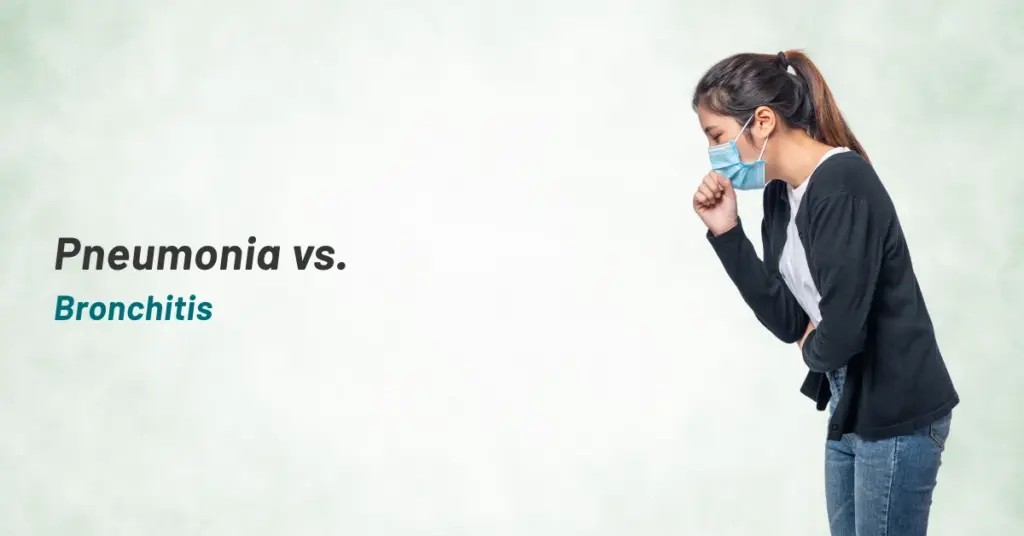Pneumonia and bronchitis are both respiratory infections that affect the lungs, but they differ in several ways, including their causes, symptoms, and treatment. Here’s a breakdown of the key distinctions between pneumonia and bronchitis:
Understanding Pneumonia and Bronchitis
Pneumonia: Pneumonia is an infection that primarily affects the air sacs in one or both lungs, causing inflammation and the accumulation of fluid or pus in the affected areas.
Bronchitis: The less severe of the two, bronchitis is an inflammation of the bronchial tubes (air passages) that carry air to and from the lungs. It can be acute (short-term) or chronic (long-term).
Causes
Pneumonia is often caused by bacterial, viral, or fungal infections. Streptococcus pneumoniae, Haemophilusinfluenzae, and various respiratory viruses are common culprits.
Acute bronchitis is typically caused by viral infections, such as the common cold or influenza viruses. Chronic bronchitis is usually associated with long-term exposure to irritants like smoking or air pollution.
Symptoms
Pneumonia symptoms typically include
➤ High fever with chills and sweating
➤ Cough with thick, yellow or green mucus
➤ Shortness of breath and rapid breathing
➤ Chest pain that worsens with coughing or deep breathing
➤ Fatigue and weakness
➤ Bluish lips or nails (in severe cases)
Bronchitis symptoms typically include
➤ Persistent cough, often with clear or white mucus
➤ Mild to moderate fever
➤ Chest discomfort or tightness
➤ Wheezing and shortness of breath
➤ Fatigue and mild body aches
Duration
Pneumonia can vary in duration but is generally more severe and longer-lasting than acute bronchitis. Recovery may take weeks, and in some cases, hospitalization may be necessary.
Acute bronchitis usually lasts for a few weeks and often resolves on its own, while chronic bronchitis is a long-term condition that persists for at least three months over two consecutive years.
Diagnosis
Diagnosis is typically made through a combination of physical examination, chest X-rays, and sometimes blood tests to identify the underlying cause (bacterial or viral).
Diagnosis is usually based on symptoms and medical history. Tests may not be necessary for uncomplicated cases of acute bronchitis.
Treatment
Pneumonia treatment may involve antibiotics for bacterial pneumonia, antiviral medication for viral pneumonia, rest, hydration, and sometimes hospitalization for severe cases. Pneumonia can quickly become life-threatening, so anyone with a compromised immune system, any underlying health condition, the elderly, or young children should see a doctor if they develop symptoms.
Acute bronchitis is often managed with rest, hydration, over-the-counter cough suppressants, and time. If it’s caused by a bacterial infection, antibiotics may be prescribed. For chronic bronchitis, managing underlying causes (e.g., smoking cessation) and medications to relieve symptoms are common approaches.
Prevention
The Centers for Disease Control and Prevention (CDC) recommends people with or at risk for COPD get a yearly flu (influenza) vaccine.
• People with chronic lung disease, should also get pneumococcal vaccines; once as an adult before 65 years old and twice at 65 years or older.
When to see a doctor?
While both pneumonia and bronchitis involve respiratory symptoms, they differ in terms of their causes, severity, and specific symptoms. It’s important to seek medical attention if you suspect you have either condition, especially if your symptoms are severe or if you have underlying health conditions that may increase the risk of complications. Proper diagnosis and treatment are essential for a full recovery. Remember, if you get treatment right away, it will cut down significantly the amount of time you need to recover.









